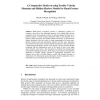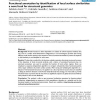10 search results - page 2 / 2 » Analysis of the Hindi Proposition Bank using Dependency Stru... |
LICS
2009
IEEE
13 years 11 months ago
2009
IEEE
Game semantics describe the interactive behavior of proofs by interpreting formulas as games on which proofs induce strategies. Such a semantics is introduced here for capturing d...
AMDO
2008
Springer
13 years 6 months ago
2008
Springer
Hand-gesture recognition presents a challenging problem for computer vision due to the articulated structure of the human hand and the complexity of the environments in which it is...
BMCBI
2005
13 years 4 months ago
2005
Background: Protein function is often dependent on subsets of solvent-exposed residues that may exist in a similar three-dimensional configuration in non homologous proteins thus ...
BMCBI
2008
13 years 5 months ago
2008
Background: The explosive growth of biological data provides opportunities for new statistical and comparative analyses of large information sets, such as alignments comprising te...
BMCBI
2008
13 years 5 months ago
2008
Background: A multiple sequence alignment (MSA) generated for a protein can be used to characterise residues by means of a statistical analysis of single columns. In addition to t...


